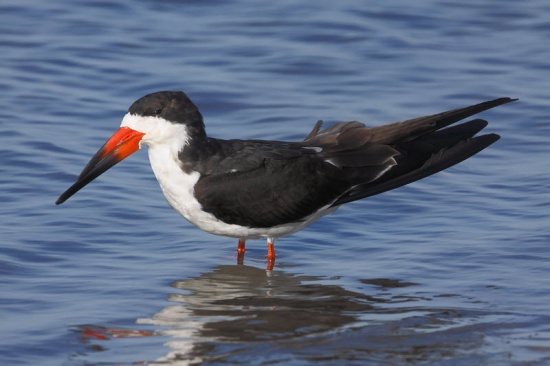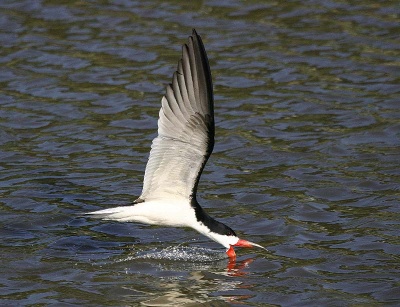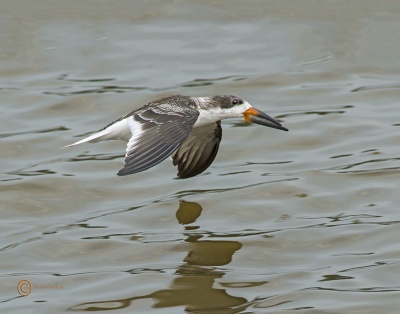(additional photo) |
(Picture captions and References updated) |
||
| Line 1: | Line 1: | ||
| − | [[Image:609-06310fg Black Skimmer.jpg|thumb|550px|right| | + | [[Image:609-06310fg Black Skimmer.jpg|thumb|550px|right|Adult<br />Photo by {{user|bobsofpa|bobsofpa}}<br />Fort Island Gulf Beach, Crystal River, [[Florida]], March 2009 ]] |
;[[:Category:Rynchops|Rynchops]] niger | ;[[:Category:Rynchops|Rynchops]] niger | ||
==Identification: == | ==Identification: == | ||
| Line 8: | Line 8: | ||
*Bill red with black tip like a blade. Lower mandible much longer, than the upper<br /> | *Bill red with black tip like a blade. Lower mandible much longer, than the upper<br /> | ||
'''Immature''' mottled upper appearance, with shorter bill. | '''Immature''' mottled upper appearance, with shorter bill. | ||
| − | [[Image:Black_Skimmer.jpg|thumb|400px|right| | + | [[Image:Black_Skimmer.jpg|thumb|400px|right|Typical feeding behavior<br />Photo by {{user|Nick+Richter|Nick Richter}}<br />San Diego Creek, Irvine, [[California]], May 2004]] |
==Distribution== | ==Distribution== | ||
Breeds along Atlantic and Gulf coasts from [[Massachusetts]] and [[Long Island]] to [[Florida]] and [[Texas]]. Winters north to southern [[California]] and [[Virginia]]. Also in American tropics. | Breeds along Atlantic and Gulf coasts from [[Massachusetts]] and [[Long Island]] to [[Florida]] and [[Texas]]. Winters north to southern [[California]] and [[Virginia]]. Also in American tropics. | ||
==Taxonomy== | ==Taxonomy== | ||
| − | ====Subspecies | + | ====Subspecies==== |
| − | [[Image:Black_Skimmer_juvie_0646_by_STEFFRO1.jpg|thumb|400px|right| | + | [[Image:Black_Skimmer_juvie_0646_by_STEFFRO1.jpg|thumb|400px|right|Immature<br />Photo by {{user|STEFFRO1|STEFFRO1}}<br />Huntington Beach State Park, [[South Carolina]], August 2013]] |
| − | There are 3 subspecies: | + | There are 3 subspecies<sup>[[#References|[1]]]</sup>: |
*''R. n. niger '': | *''R. n. niger '': | ||
:*Coastal [[US]] and [[Mexico]]; winters to [[Panama]] | :*Coastal [[US]] and [[Mexico]]; winters to [[Panama]] | ||
| Line 35: | Line 35: | ||
Short barking notes. | Short barking notes. | ||
==Reference== | ==Reference== | ||
| − | #{{Ref- | + | #{{Ref-Clements6thAug16}}#eNature |
{{ref}} | {{ref}} | ||
==External Links== | ==External Links== | ||
Revision as of 09:38, 12 June 2017
- Rynchops niger
Identification:
18" (46 cm)
- Black above
- White below
- Red legs
- Bill red with black tip like a blade. Lower mandible much longer, than the upper
Immature mottled upper appearance, with shorter bill.
Distribution
Breeds along Atlantic and Gulf coasts from Massachusetts and Long Island to Florida and Texas. Winters north to southern California and Virginia. Also in American tropics.
Taxonomy
Subspecies
There are 3 subspecies[1]:
- R. n. niger :
- R. n. cinerascens:
- Coasts and rivers of northern South America to Bolivia and north-western Argentina
- R. n. intercedens:
Habitat
Breeds chiefly on sandbars and beaches; feeds in shallow bays, inlets, and estuaries.
Behaviour
Tight flocks can be seen simultaneously wheeling in one direction and then another.
Diet
They are mainly surface skimmers (hence the name) tip of the lower mandible cuts through the water. They will also wade in shallow water, jabbing at the fish.
Breeding
3 or 4 brown-blotched buff eggs on bare sand, usually among shell fragments and scattered grass clumps.
They are particularly attracted to the newly-dredged sand-fill areas, which may contain colonies of up to 200 pairs. These sites will be abandoned as soon as too much grass appears.
Vocalisation
Short barking notes.
Reference
- Clements, J. F., T. S. Schulenberg, M. J. Iliff, D. Roberson, T. A. Fredericks, B. L. Sullivan, and C. L. Wood. 2016. The eBird/Clements checklist of birds of the world: v2016, with updates to August 2016. Downloaded from http://www.birds.cornell.edu/clementschecklist/download/
- eNature
Recommended Citation
- BirdForum Opus contributors. (2024) Black Skimmer. In: BirdForum, the forum for wild birds and birding. Retrieved 19 April 2024 from https://www.birdforum.net/opus/Black_Skimmer






